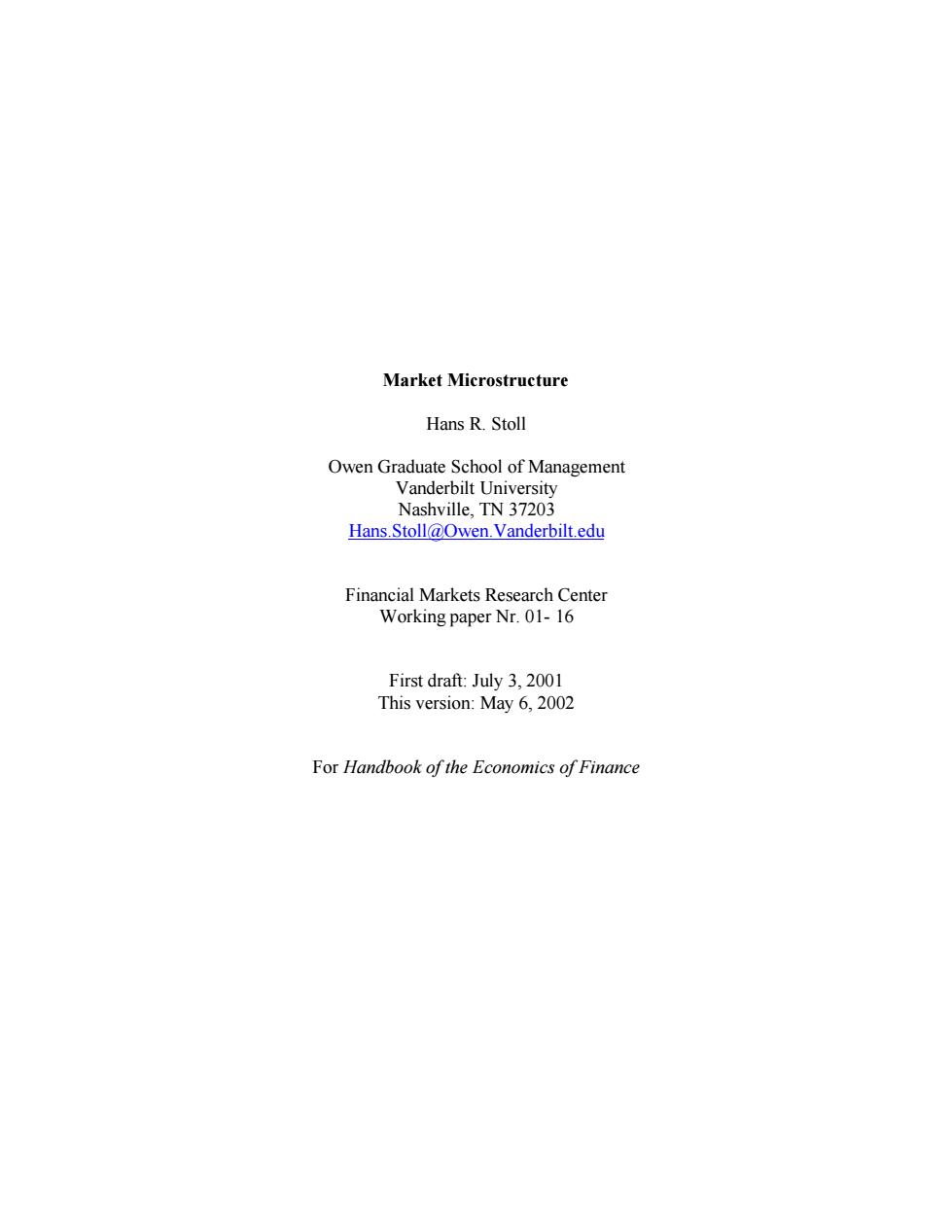
Market Microstructure Hans R.Stoll Owen Graduate School of Management Vanderbilt University Nashville,TN 37203 Hans.Stoll@Owen.Vanderbilt.edu Financial Markets Research Center Working paper Nr.01-16 First draft:July 3,2001 This version:May 6,2002 For Handbook of the Economics of Finance
Market Microstructure Hans R. Stoll Owen Graduate School of Management Vanderbilt University Nashville, TN 37203 Hans.Stoll@Owen.Vanderbilt.edu Financial Markets Research Center Working paper Nr. 01- 16 First draft: July 3, 2001 This version: May 6, 2002 For Handbook of the Economics of Finance
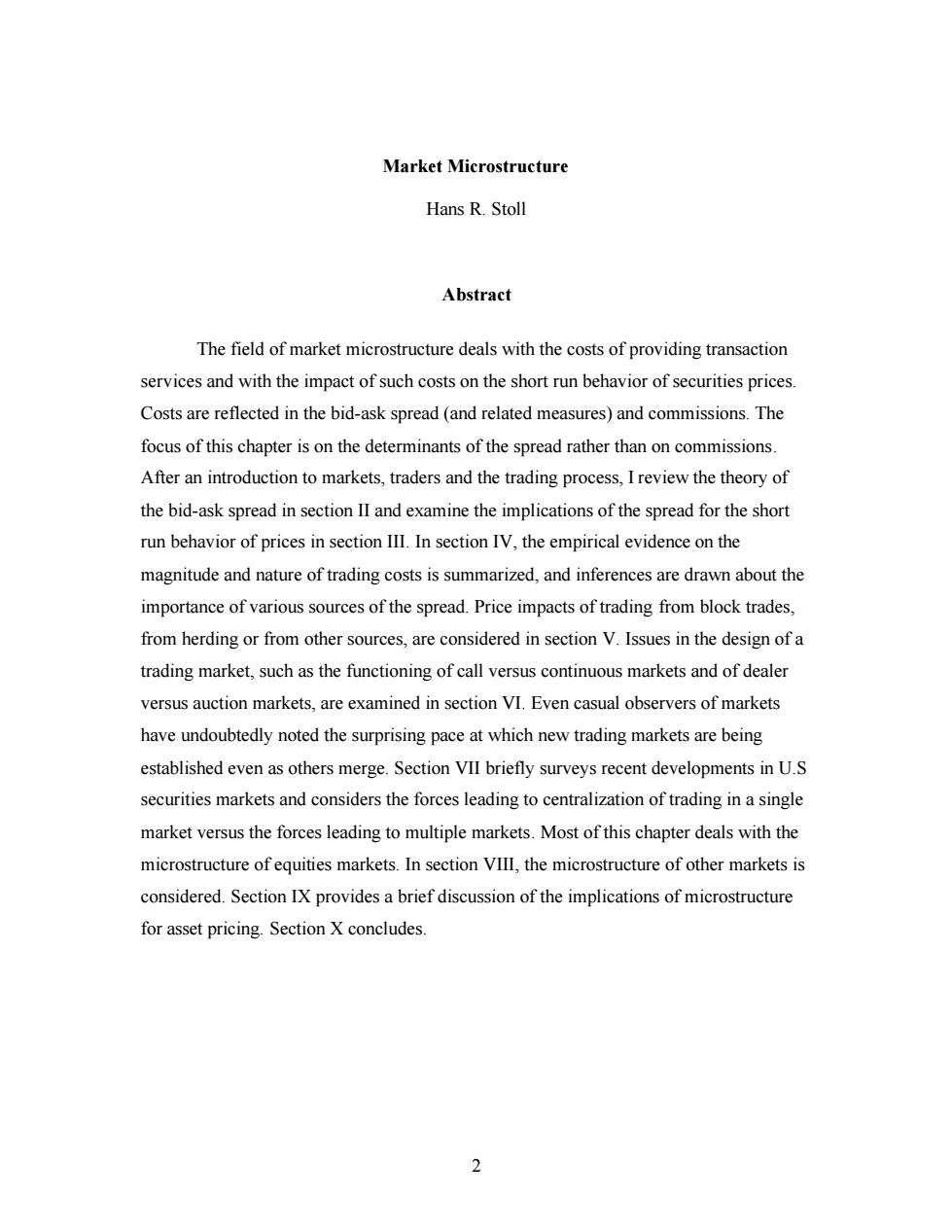
Market Microstructure Hans R.Stoll Abstract The field of market microstructure deals with the costs of providing transaction services and with the impact of such costs on the short run behavior of securities prices. Costs are reflected in the bid-ask spread (and related measures)and commissions.The focus of this chapter is on the determinants of the spread rather than on commissions. After an introduction to markets,traders and the trading process,I review the theory of the bid-ask spread in section II and examine the implications of the spread for the short run behavior of prices in section III.In section IV,the empirical evidence on the magnitude and nature of trading costs is summarized,and inferences are drawn about the importance of various sources of the spread.Price impacts of trading from block trades, from herding or from other sources,are considered in section V.Issues in the design of a trading market,such as the functioning of call versus continuous markets and of dealer versus auction markets,are examined in section VI.Even casual observers of markets have undoubtedly noted the surprising pace at which new trading markets are being established even as others merge.Section VII briefly surveys recent developments in U.S securities markets and considers the forces leading to centralization of trading in a single market versus the forces leading to multiple markets.Most of this chapter deals with the microstructure of equities markets.In section VIlI,the microstructure of other markets is considered.Section IX provides a brief discussion of the implications of microstructure for asset pricing.Section X concludes. 2
2 Market Microstructure Hans R. Stoll Abstract The field of market microstructure deals with the costs of providing transaction services and with the impact of such costs on the short run behavior of securities prices. Costs are reflected in the bid-ask spread (and related measures) and commissions. The focus of this chapter is on the determinants of the spread rather than on commissions. After an introduction to markets, traders and the trading process, I review the theory of the bid-ask spread in section II and examine the implications of the spread for the short run behavior of prices in section III. In section IV, the empirical evidence on the magnitude and nature of trading costs is summarized, and inferences are drawn about the importance of various sources of the spread. Price impacts of trading from block trades, from herding or from other sources, are considered in section V. Issues in the design of a trading market, such as the functioning of call versus continuous markets and of dealer versus auction markets, are examined in section VI. Even casual observers of markets have undoubtedly noted the surprising pace at which new trading markets are being established even as others merge. Section VII briefly surveys recent developments in U.S securities markets and considers the forces leading to centralization of trading in a single market versus the forces leading to multiple markets. Most of this chapter deals with the microstructure of equities markets. In section VIII, the microstructure of other markets is considered. Section IX provides a brief discussion of the implications of microstructure for asset pricing. Section X concludes
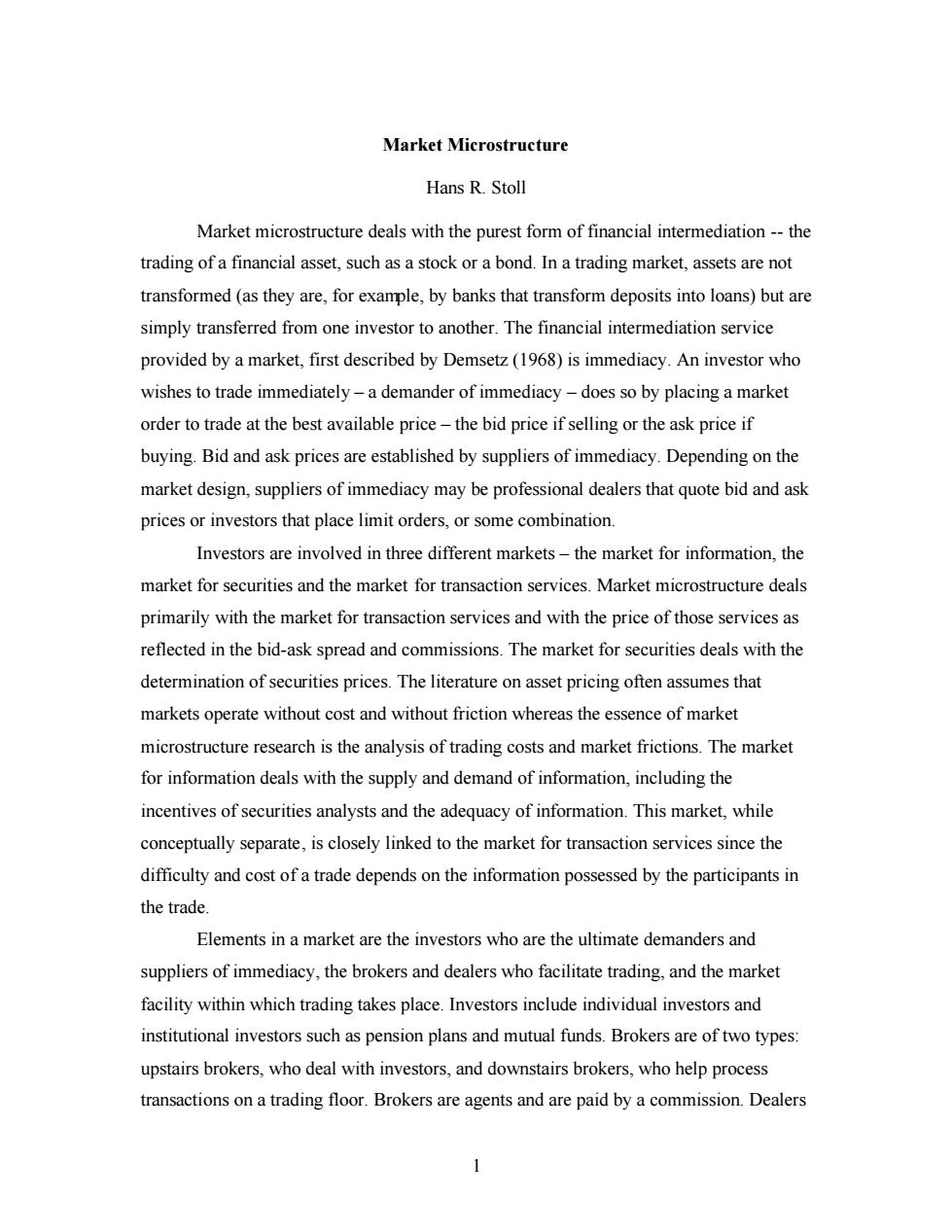
Market Microstructure Hans R.Stoll Market microstructure deals with the purest form of financial intermediation--the trading of a financial asset,such as a stock or a bond.In a trading market,assets are not transformed(as they are,for example,by banks that transform deposits into loans)but are simply transferred from one investor to another.The financial intermediation service provided by a market,first described by Demsetz(1968)is immediacy.An investor who wishes to trade immediately-a demander of immediacy-does so by placing a market order to trade at the best available price-the bid price if selling or the ask price if buying.Bid and ask prices are established by suppliers of immediacy.Depending on the market design,suppliers of immediacy may be professional dealers that quote bid and ask prices or investors that place limit orders,or some combination. Investors are involved in three different markets-the market for information,the market for securities and the market for transaction services.Market microstructure deals primarily with the market for transaction services and with the price of those services as reflected in the bid-ask spread and commissions.The market for securities deals with the determination of securities prices.The literature on asset pricing often assumes that markets operate without cost and without friction whereas the essence of market microstructure research is the analysis of trading costs and market frictions.The market for information deals with the supply and demand of information,including the incentives of securities analysts and the adequacy of information.This market,while conceptually separate,is closely linked to the market for transaction services since the difficulty and cost of a trade depends on the information possessed by the participants in the trade. Elements in a market are the investors who are the ultimate demanders and suppliers of immediacy,the brokers and dealers who facilitate trading,and the market facility within which trading takes place.Investors include individual investors and institutional investors such as pension plans and mutual funds.Brokers are of two types: upstairs brokers,who deal with investors,and downstairs brokers,who help process transactions on a trading floor.Brokers are agents and are paid by a commission.Dealers 1
1 Market Microstructure Hans R. Stoll Market microstructure deals with the purest form of financial intermediation -- the trading of a financial asset, such as a stock or a bond. In a trading market, assets are not transformed (as they are, for example, by banks that transform deposits into loans) but are simply transferred from one investor to another. The financial intermediation service provided by a market, first described by Demsetz (1968) is immediacy. An investor who wishes to trade immediately – a demander of immediacy – does so by placing a market order to trade at the best available price – the bid price if selling or the ask price if buying. Bid and ask prices are established by suppliers of immediacy. Depending on the market design, suppliers of immediacy may be professional dealers that quote bid and ask prices or investors that place limit orders, or some combination. Investors are involved in three different markets – the market for information, the market for securities and the market for transaction services. Market microstructure deals primarily with the market for transaction services and with the price of those services as reflected in the bid-ask spread and commissions. The market for securities deals with the determination of securities prices. The literature on asset pricing often assumes that markets operate without cost and without friction whereas the essence of market microstructure research is the analysis of trading costs and market frictions. The market for information deals with the supply and demand of information, including the incentives of securities analysts and the adequacy of information. This market, while conceptually separate, is closely linked to the market for transaction services since the difficulty and cost of a trade depends on the information possessed by the participants in the trade. Elements in a market are the investors who are the ultimate demanders and suppliers of immediacy, the brokers and dealers who facilitate trading, and the market facility within which trading takes place. Investors include individual investors and institutional investors such as pension plans and mutual funds. Brokers are of two types: upstairs brokers, who deal with investors, and downstairs brokers, who help process transactions on a trading floor. Brokers are agents and are paid by a commission. Dealers
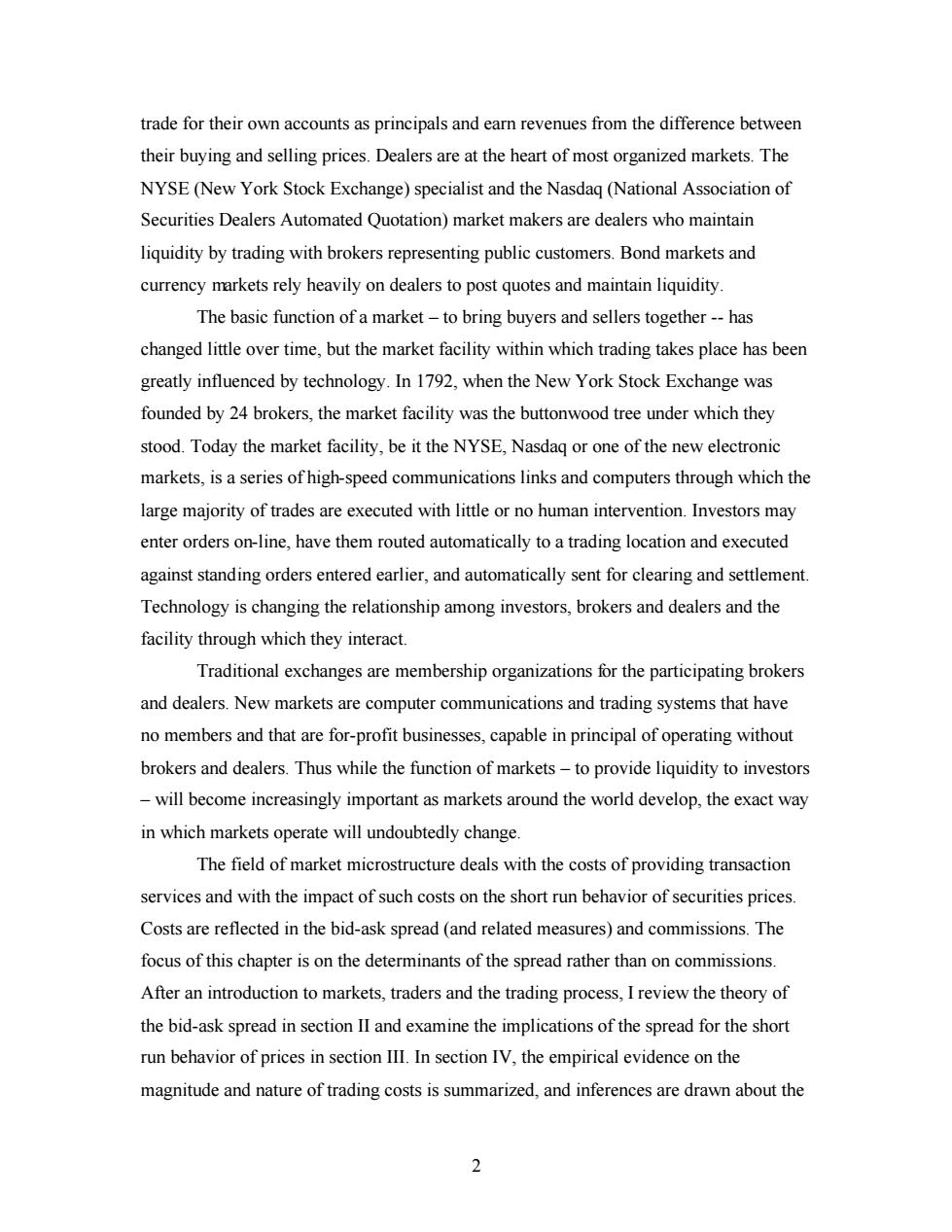
trade for their own accounts as principals and earn revenues from the difference between their buying and selling prices.Dealers are at the heart of most organized markets.The NYSE(New York Stock Exchange)specialist and the Nasdaq(National Association of Securities Dealers Automated Quotation)market makers are dealers who maintain liquidity by trading with brokers representing public customers.Bond markets and currency markets rely heavily on dealers to post quotes and maintain liquidity The basic function of a market-to bring buyers and sellers together--has changed little over time,but the market facility within which trading takes place has been greatly influenced by technology.In 1792,when the New York Stock Exchange was founded by 24 brokers,the market facility was the buttonwood tree under which they stood.Today the market facility,be it the NYSE,Nasdaq or one of the new electronic markets,is a series ofhigh-speed communications links and computers through which the large majority of trades are executed with little or no human intervention.Investors may enter orders on-line,have them routed automatically to a trading location and executed against standing orders entered earlier,and automatically sent for clearing and settlement. Technology is changing the relationship among investors,brokers and dealers and the facility through which they interact. Traditional exchanges are membership organizations for the participating brokers and dealers.New markets are computer communications and trading systems that have no members and that are for-profit businesses,capable in principal of operating without brokers and dealers.Thus while the function of markets-to provide liquidity to investors -will become increasingly important as markets around the world develop,the exact way in which markets operate will undoubtedly change. The field of market microstructure deals with the costs of providing transaction services and with the impact of such costs on the short run behavior of securities prices. Costs are reflected in the bid-ask spread(and related measures)and commissions.The focus of this chapter is on the determinants of the spread rather than on commissions. After an introduction to markets,traders and the trading process,I review the theory of the bid-ask spread in section II and examine the implications of the spread for the short run behavior of prices in section III.In section IV,the empirical evidence on the magnitude and nature of trading costs is summarized,and inferences are drawn about the 2
2 trade for their own accounts as principals and earn revenues from the difference between their buying and selling prices. Dealers are at the heart of most organized markets. The NYSE (New York Stock Exchange) specialist and the Nasdaq (National Association of Securities Dealers Automated Quotation) market makers are dealers who maintain liquidity by trading with brokers representing public customers. Bond markets and currency markets rely heavily on dealers to post quotes and maintain liquidity. The basic function of a market – to bring buyers and sellers together -- has changed little over time, but the market facility within which trading takes place has been greatly influenced by technology. In 1792, when the New York Stock Exchange was founded by 24 brokers, the market facility was the buttonwood tree under which they stood. Today the market facility, be it the NYSE, Nasdaq or one of the new electronic markets, is a series of high-speed communications links and computers through which the large majority of trades are executed with little or no human intervention. Investors may enter orders on-line, have them routed automatically to a trading location and executed against standing orders entered earlier, and automatically sent for clearing and settlement. Technology is changing the relationship among investors, brokers and dealers and the facility through which they interact. Traditional exchanges are membership organizations for the participating brokers and dealers. New markets are computer communications and trading systems that have no members and that are for-profit businesses, capable in principal of operating without brokers and dealers. Thus while the function of markets – to provide liquidity to investors – will become increasingly important as markets around the world develop, the exact way in which markets operate will undoubtedly change. The field of market microstructure deals with the costs of providing transaction services and with the impact of such costs on the short run behavior of securities prices. Costs are reflected in the bid-ask spread (and related measures) and commissions. The focus of this chapter is on the determinants of the spread rather than on commissions. After an introduction to markets, traders and the trading process, I review the theory of the bid-ask spread in section II and examine the implications of the spread for the short run behavior of prices in section III. In section IV, the empirical evidence on the magnitude and nature of trading costs is summarized, and inferences are drawn about the
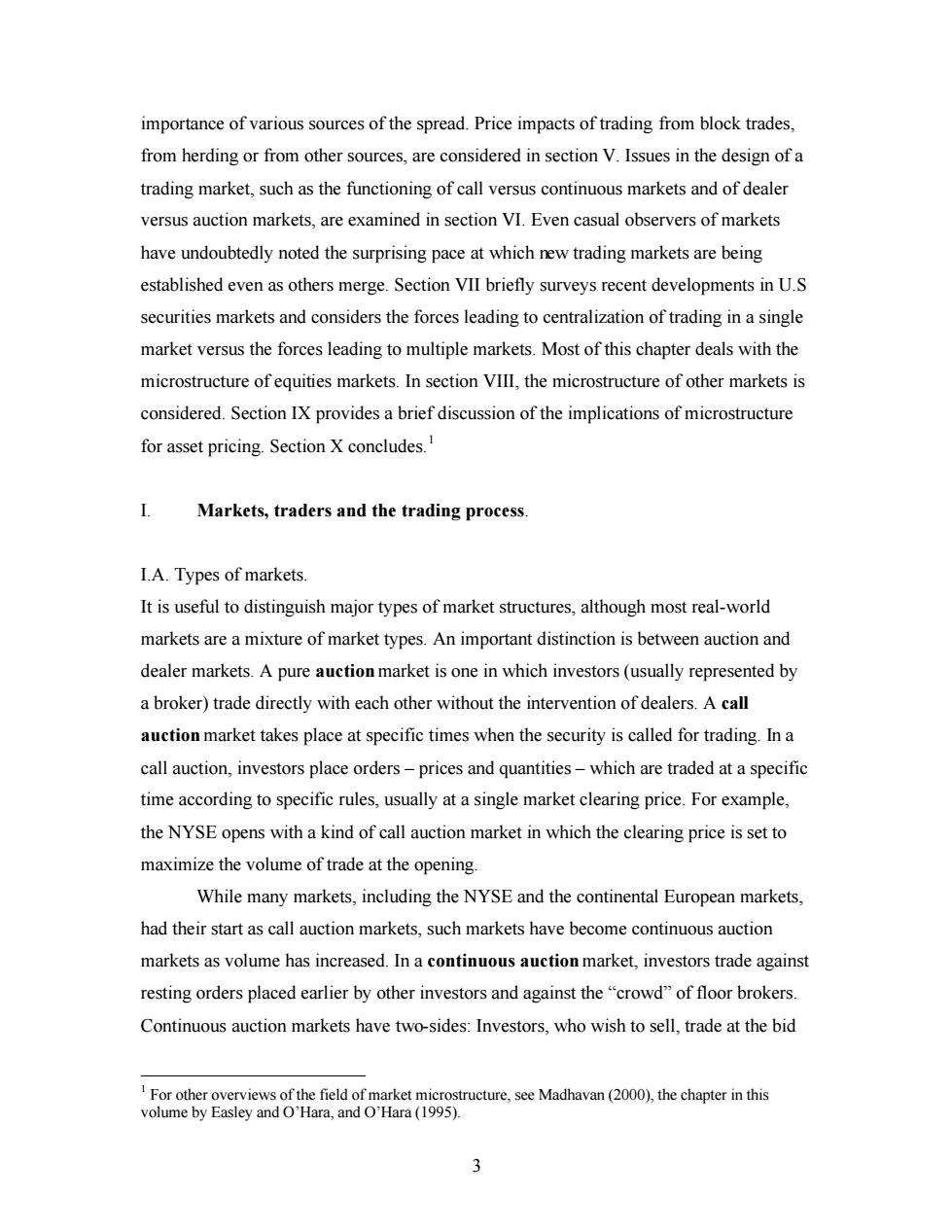
importance of various sources of the spread.Price impacts of trading from block trades, from herding or from other sources,are considered in section V.Issues in the design of a trading market,such as the functioning of call versus continuous markets and of dealer versus auction markets,are examined in section VI.Even casual observers of markets have undoubtedly noted the surprising pace at which new trading markets are being established even as others merge.Section VII briefly surveys recent developments in U.S securities markets and considers the forces leading to centralization of trading in a single market versus the forces leading to multiple markets.Most of this chapter deals with the microstructure of equities markets.In section VIll,the microstructure of other markets is considered.Section IX provides a brief discussion of the implications of microstructure for asset pricing.Section X concludes. Markets,traders and the trading process. I.A.Types of markets. It is useful to distinguish major types of market structures,although most real-world markets are a mixture of market types.An important distinction is between auction and dealer markets.A pure auction market is one in which investors(usually represented by a broker)trade directly with each other without the intervention of dealers.A call auction market takes place at specific times when the security is called for trading.In a call auction,investors place orders-prices and quantities-which are traded at a specific time according to specific rules,usually at a single market clearing price.For example, the NYSE opens with a kind of call auction market in which the clearing price is set to maximize the volume of trade at the opening. While many markets,including the NYSE and the continental European markets, had their start as call auction markets,such markets have become continuous auction markets as volume has increased.In a continuous auction market,investors trade against resting orders placed earlier by other investors and against the "crowd"of floor brokers. Continuous auction markets have two-sides:Investors,who wish to sell,trade at the bid For other overviews of the field of market microstructure,see Madhavan(2000),the chapter in this volume by Easley and O'Hara,and O'Hara(1995)
3 importance of various sources of the spread. Price impacts of trading from block trades, from herding or from other sources, are considered in section V. Issues in the design of a trading market, such as the functioning of call versus continuous markets and of dealer versus auction markets, are examined in section VI. Even casual observers of markets have undoubtedly noted the surprising pace at which new trading markets are being established even as others merge. Section VII briefly surveys recent developments in U.S securities markets and considers the forces leading to centralization of trading in a single market versus the forces leading to multiple markets. Most of this chapter deals with the microstructure of equities markets. In section VIII, the microstructure of other markets is considered. Section IX provides a brief discussion of the implications of microstructure for asset pricing. Section X concludes.1 I. Markets, traders and the trading process. I.A. Types of markets. It is useful to distinguish major types of market structures, although most real-world markets are a mixture of market types. An important distinction is between auction and dealer markets. A pure auction market is one in which investors (usually represented by a broker) trade directly with each other without the intervention of dealers. A call auction market takes place at specific times when the security is called for trading. In a call auction, investors place orders – prices and quantities – which are traded at a specific time according to specific rules, usually at a single market clearing price. For example, the NYSE opens with a kind of call auction market in which the clearing price is set to maximize the volume of trade at the opening. While many markets, including the NYSE and the continental European markets, had their start as call auction markets, such markets have become continuous auction markets as volume has increased. In a continuous auction market, investors trade against resting orders placed earlier by other investors and against the “crowd” of floor brokers. Continuous auction markets have two-sides: Investors, who wish to sell, trade at the bid 1 For other overviews of the field of market microstructure, see Madhavan (2000), the chapter in this volume by Easley and O’Hara, and O’Hara (1995)